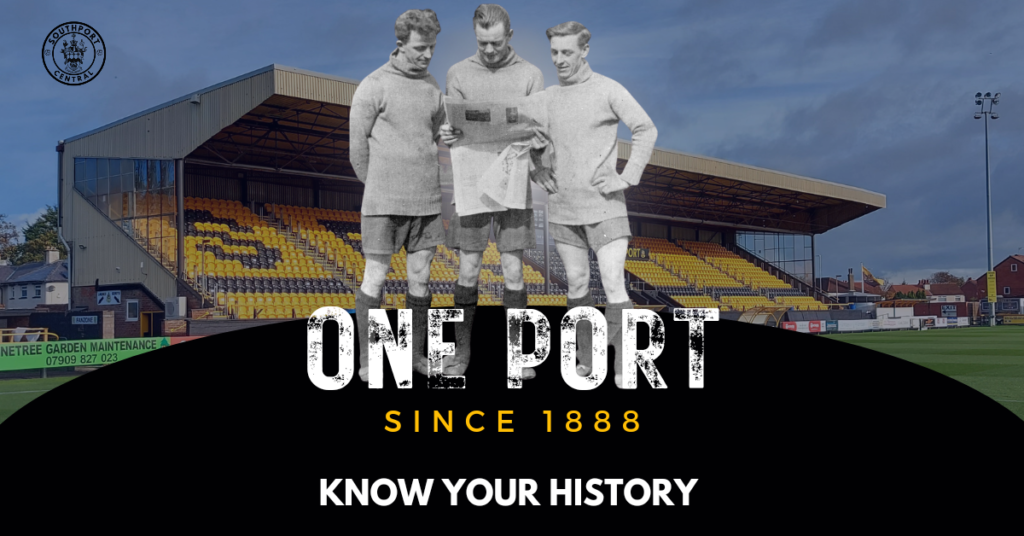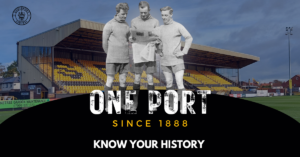Southport Football Club has a proud and complex history. Its name runs through almost a century and a half of the town’s sporting life, from the earliest experiments with rugby and association football to the modern day. Yet in 2025 the picture of that history remains oddly inconsistent.
Across the club’s public face, the story changes depending on where you look. Some materials use 1881, others 1888. Even the way statistics are presented can sometimes give the impression that the Southport which played in the Football League before 1978 was a different club altogether. Taken together, it all points to an organisation that has never quite settled on how to tell its own story.
That inconsistency has become so familiar that it sometimes passes without comment. This season, merchandise and sponsorship materials have continued to display the year 1881, while an official hospitality communication referred to 1882 – an error so obvious and so widely shared that it raised a smile. The message promised an “exclusive 1882 signed football” as part of a package, but what the error really highlighted was something deeper: that we are giving sponsors and guests meaningful keepsakes carrying the wrong formation year. It is a small detail, but it matters. Meanwhile, official correspondence issued to other clubs now correctly lists 1888, the year Southport Central Association Football Club was formed. Each of these examples tells a different version of history, and together they reveal a club still struggling to speak with one voice.
The irony is that the evidence is clear, extensive and beyond dispute. The research undertaken for The Town’s Game and other recent work has confirmed that Southport FC, as we know it today, was founded in 1888. The persistence of alternative dates is no longer a matter of uncertainty; it is one of communication.
When the “1881 Lounge” was unveiled beneath the Main Stand in 2018 I welcomed it. After years in which the club’s heritage had felt neglected, it seemed like a positive step. I knew that the 1881 claim was open to question, but I understood why people wanted to use it. It felt like a symbol of continuity, something that linked the modern club with the beginnings of football in the town. At the time I even tried to make sense of it in print. Six years later, with the benefit of further research and a far clearer understanding of the early years, I can say with certainty that the club we support today was not founded in 1881. That is not opinion; it is record.
Association football came to Southport in 1881 when a team called Southport Football Club switched from rugby to association rules and played its first match against Bootle Second XI on 12 November. That team folded five years later. In fact, four separate clubs carried the Southport Football Club name between 1872 and 1886, each rising and falling in turn as rugby and football competed for popularity. The last of those early sides merged with Southport Wanderers in 1886, and two years later a completely new organisation was formed: Southport Central Association Football Club. Central was a new club with a new name, a new ground, a new committee, a new strip and a new ambition to compete at a professional level. Contemporary reports are clear that it was a new entity. Even at its own annual meeting in 1889 it described itself as being one year old.
This was confirmed beyond doubt by the Liverpool Daily Post of 8 March 1935, which published the minutes of the founding meeting, supplied by Norman Ramsbottom, whose father Edwin had served as Central’s first secretary. Edwin’s notes were a first-hand account and left no doubt that 1888 marked a new beginning rather than a continuation. Edwin himself had played for the original association club as a 14-year-old in 1881, making the connection between the two generations of Southport football explicit. Few families were more deeply embedded in the town’s sporting story, and few testimonies could carry greater weight. The conclusion is inescapable. The Southport Football Club that exists today began life in 1888.
Some will still ask what difference it makes. The answer lies in authenticity. A club that represents its town must be confident in the truth of its own origins. Recognising 1888 does not erase 1881; it places it in context. The 1881 club represents the birth of association football in Southport, the moment the town took up the sport that would define it. That is something to celebrate, and in that sense the name of the 1881 Lounge remains a fitting tribute. But it should not be mistaken for the founding date of this club.
Even now, the way the club’s history is presented can feel fragmented. The match programme, for example, tends to focus on statistics covering the period from 1978 onwards. These records are often labelled as Non-League statistics, even when they could also include matches from the Football League years and earlier. It is not an intentional slight or a conscious choice to draw a dividing line; it is simply the continuation of a long-standing approach. Yet over time it risks reinforcing the idea that Southport’s history exists in two disconnected halves, before and after 1978, rather than as one continuous record stretching back to 1888. It is a small distinction, but small distinctions matter when they are repeated often enough.
If those inherited habits in print have grown over time, the merchandise represents something newer and harder to explain. This season the club shop has been filled with brand-new items carrying the date 1881. Some have even been seen worn by the new owners, keen to show pride in the club and a sense of belonging among supporters. Their enthusiasm is understandable and their intentions good, yet the message these products send is confused. To continue producing and selling items that carry a date known to be incorrect is misleading at best. What surprises many of us is that such designs were commissioned and approved without challenge from anyone who knows the facts. It is not a question of blame but of awareness. Somewhere, the check failed. The encouraging part is that supporters themselves have already caught up. Fan-made flags now carry the correct year, 1888, and the club’s own media team recently published a video during which ran a quiz in which a supporter was congratulated for giving that very answer. The understanding among the fanbase has quietly moved on. It would be reassuring to see the official message follow.
This confused messaging is not confined to the club’s history. It fits a wider pattern of inconsistency that seeps into small but telling details. This is, after all, the same club that has spent years uncertain about the names of the stands in its own ground. Even the famous terrace has suffered from muddled labelling, with “Poplar” and “Popular” used interchangeably despite the latter being correct. Individually these slips might seem harmless, but together they reflect a lack of care in how the club presents itself. Names and dates matter because they speak to identity. When a club cannot be precise about its own heritage or even its own geography, it invites the perception that accuracy does not matter.
None of this is beyond repair. In fact, the club is closer than ever to establishing a consistent and authentic identity. Some of its official correspondence already uses the correct formation year. The next step is to make that consistency visible across every platform, from merchandise and marketing to matchday materials and the website. The solution is not to erase 1881 but to celebrate it correctly, as the year association football first arrived in the town. Doing so would allow Southport to present itself with clarity and confidence, proud of both its heritage and its honesty.
Southport’s story is richer than any single number printed on a shirt. It is the story of a town that embraced football early, of clubs that came and went, and of one that endured. The team that walks out at Haig Avenue today is the direct descendant of Southport Central, founded in 1888. Its history is unbroken from that point onwards, and the players, managers and supporters who have carried it through every decade belong to that same lineage. Acknowledging that truth does not divide the past; it connects it. 1888 may not be as familiar a number to print on a scarf, but it is the right one, and the right one is something to be proud of.
I’m not interested in pointing fingers. The club has made huge strides off the field this season and deserves real credit for that progress. My concern is that inconsistencies, things like formation dates, historical references and the way we present ourselves, have a quiet way of undermining that good work. What’s needed now is a consistent, grown-up approach, and a little more care in how we tell our story. The history deserves that level of respect, and so does the club we’ve become.
DJH
Other reading
Disclaimer
This article is published independently by Southport Central. The views expressed are those of the author. The historical research referenced is based on The Town’s Game by Daniel Hayes, and The Sandgrounders by Geoff Wilde and Michael Braham. Southport Central is affiliated with the Football Supporters’ Association and regulated by IMPRESS.
Discover more from Southport Central
Subscribe to get the latest posts sent to your email.

 0 - 0 v Kings Lynn Town (H) 01/11/2025
0 - 0 v Kings Lynn Town (H) 01/11/2025 




More Stories
From Ash Lane to Bramley-Moore: The Ashes return to the Lancashire coast
The Price Of Saying No
Friday Night Football